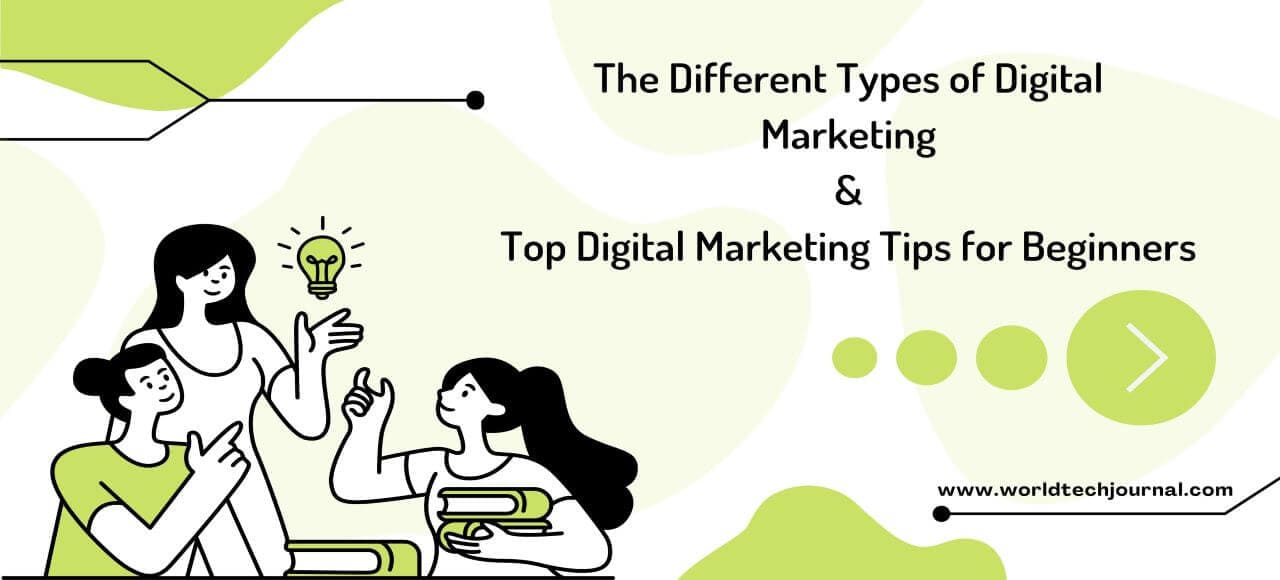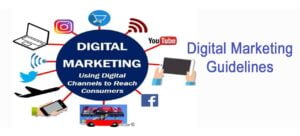In this detail guide you will know almost everything about digital marketing, types of digital marketing with some tips and tricks for beginners at this essential field.
Any kind of marketing that can be measured by marketing experts across the consumer journey and that leverages electronic devices to deliver promotional content.
Digital marketing is most often used to describe advertising efforts that run on a computer, phone, tablet, or other electronic device.
Online video, display advertisements, search engine marketing, paid social ads, and social media reach are just a few examples of the many formats it may take.
Digital marketing is often contrasted with “conventional marketing” methods like direct mail, billboards, and magazine advertisements. Oddly, conventional marketing is sometimes grouped with television.
Did you know that over 34% of Americans regularly use the internet? Additionally, 43% of users log on more than once every day, and 26% are “almost continually” online.
These numbers are significantly higher among internet users who utilize mobile devices. 89% of Americans use the internet at least once every day, and 31% use it frequently.
As a marketer, it’s crucial to use the digital sphere via online advertising, brand development, offering excellent customer service that attracts more prospective consumers, and more.
Utilizing several digital channels, including social media, pay-per-click advertising, search engine optimization, as well as email marketing, can enable you to engage with current clients and potential consumers.
Besides, plus marketing tools are a great way to promote your business. As these tools save up plenty of time and do the job in the quickest way possible.
As a consequence, you may create a strong brand, provide excellent customer service, attract new clients, and more.
What is digital marketing?
Digital marketing, often known as online marketing, is the promotion of companies utilizing the internet and other digital communication channels to reach prospective clients.

Text and multimedia messages are also considered a kind of marketing, in addition to email, social media, and web-based advertising.
Basically, a marketing campaign is digital marketing if it uses digital communication.
Compared to digital marketing, inbound marketing
Inbound marketing and digital marketing often get mixed up, and for good reason.
Email and web content are only a few of the numerous methods that are used in both digital marketing and inbound marketing.
Both exist in order to attract prospects and convert them into customers during the buyer’s journey.
However, the two methods have distinct perspectives on how the tool and the objective relate to one another.
Digital marketing takes into account the ability of certain technologies or digital platforms to convert prospects.
The digital marketing strategy of a company may use many platforms or concentrate all of its efforts on a single platform.
For instance, a business can ignore other digital marketing channels in favor of producing content only for social networking platforms and email marketing campaigns.
In contrast, inbound marketing is a comprehensive idea.
The aim is taken into account first, followed by an examination of the tools at hand to identify which will best reach the target audience and at what stage of the sales funnel that should occur.
Consider the scenario when you want to increase website traffic to produce more leads and prospects.
When creating your content marketing plan, you may concentrate on search engine optimization.
This will lead to more optimized material, such as blogs, landing sites, and more.
The most crucial thing to keep in mind regarding inbound and digital marketing is that, as a marketing expert, you don’t have to choose one over the other.
They really function best together. Inbound marketing gives digital marketing initiatives structure and direction, ensuring that each digital marketing channel serves a specific purpose.

What makes digital marketing so crucial?
Before going to the types of digital marketing, let’s learn about what makes it so important.
Any kind of marketing may make your company successful. However, due to the accessibility of digital platforms, digital marketing has grown in importance.
In reality, only in April 2022, there were 5 billion internet users worldwide.
There are several methods to leverage digital marketing strategies to reach your target audience, from social media to SMS messaging.
Digital marketing is also a low-cost marketing strategy for small enterprises because of its low upfront expenditures.
See also 7 ways how digital marketing supports E-commerce businesses.
Comparing B2B and B2C digital marketing
Both B2B (business to business) and B2C (business to consumer) organizations may benefit from digital marketing techniques, but the best practices for each are quite different.
Here’s a deeper look at how B2B and B2C marketing strategies use digital marketing.
Sales funnels for B2B customers often have lengthier decision-making cycles.
These consumers react better to relationship-building methods than B2C clients, who are more likely to favor immediate offers and messaging.
You may also like essential guide to LinkedIn outreach for generating B2B leads.
Professional B2B digital marketers give the rationale and proof that B2B purchases typically are built on.
B2C content is more likely to be emotionally driven and focused on enhancing the customer’s shopping experience.
B2B decisions often need the involvement of several people.
Marketing materials that effectively influence these choices are often shared and downloadable. Contrarily, B2C clients value personal interactions with brands.
Of course, every rule has exceptions. A B2C business with an expensive product, such a vehicle or computer, may provide more serious and educational material.
As a consequence, whether you’re in the B2B or B2C space, your digital marketing approach must always be focused on your own clientele.
For educated and focused internet marketing strategies, consider your present audience.
By doing this, you can make sure that your marketing efforts are successful and that you can draw in prospective clients.
Now let’s see how many types of digital marketing are there now.
Types of digital marketing
As there are many methods to communicate with digital media, there are also different specialties within digital marketing.
Among a lot of digital marketing strategies, here are some prime instances of various types of digital marketing strategies.
- Content marketing
- Search engine marketing
- Display Advertising
- Mobile Marketing
- Social Media Marketing
- Email Marketing
- Influencer Marketing
- Affiliate Marketing
- Video Marketing
- Audio Marketing
Let’s examine the top 10 forms of digital marketing, their advantages and disadvantages as well as some potential future steps.
1. Content marketing
Instead of just airing an advertisement, content marketing entails producing and disseminating text, images, and other types of media that are valuable to your audience.
If you’re in B2C (business to consumer), ‘content’ might include social media postings, blog articles and amusing videos;

If you’re in B2B (business to business), it can be more white papers or reports, webinars and instructive films.
Pros of content marketing
- Instead of spending money to reach a cold audience, it’s free since it focuses on luring clients to you and your business.
- Content is highly adaptable and can help you establish your brand as you educate, amuse and inspire your audience; it’s what drives all the other sorts of digital marketing, driving search engine optimization, social media, email, etc.
Cons of content marketing
- It’s a crowded market that’s difficult to stand out in since everyone is suddenly realizing the value of content and putting out blog posts, videos, and other stuff.
- You must consistently create high-quality content that satisfies your consumers’ demands, represents your brand, and advances your company’s goals if you want to be successful.
Take the following actions
Create a straightforward content plan that contains:
- In the sweet spot between what your ideal consumer wants and needs and what your brand wants to express, you want to concentrate on 4-5 essential themes;
- Your preferred format(s) (video, audio, articles, etc.);
- The platforms where you’ll publish each piece of content such as your website, on certain social networks, etc or on your website, on specific social channels, etc.
If you have a strong writing style, consider starting with a weekly blog post. If you are comfortable in front of the camera, consider doing a weekly video.
2. Search engine marketing
The goal of search engine marketing is to have your website show up at the top of search results for your brand, your goods and services, and other key terms.

Think Google (let’s face it, that’s the primary one) but also Bing (typically installed on corporate PCs, so fantastic for B2B!).
It encompasses both organic or natural search and sponsored search (pay per click, or PPC) and both desktop computers and mobiles as well as smart home assistants these days.
SEO (Search Engine Optimization)
As stated on the tin, search engine optimization optimizes for search engines.
This entails producing content that users are actively seeking for as well as ensuring that both the platforms on which it is hosted and the material itself are technically optimized.
Anybody should be doing this, regardless of the kind of company or sector they are in.
See also all you need to know about SEO.
Pros of search engine optimization
- It is unpaid!
- Customers see your brand as being more “genuine” and objective when it shows in the organic search results.
Cons of search engine optimization
- Although you don’t need to pay explicitly for the search results, it does require time and effort to produce outstanding content and optimize your website technically.
- Due to the abundance of material available today and the constantly evolving Google algorithms, it may be quite difficult to rank well in the organic results.
Take the following actions
Prepare a content strategy since content is where SEO starts.
Find out what people are looking for by doing some keyword research, and attempt to keep up with Google’s most recent changes.
If you’re just getting started, you can use a plug-in to assist with site optimization such as Yoast for WordPress or, if you have a larger budget, you may hire an expert to do a more competent job.
PPC
Paid search advertising includes programs like Google AdWords or Bing Ads.
With the exception of where it displays on the page at the top, in a little box labeled “Ad,” it resembles the natural search results nearly exactly.
A top position may be purchased via an auction depending on demographics, geography, and keywords;
This is particularly helpful for local companies and e-commerce business.
Pros of PPC
- If you’re prepared to spend money on PPC, you may easily purchase a high ranking.
- (Hence the name!) You only get charged when someone clicks.
Cons of PPC
- Costs might add up, particularly if you target popular phrases.
- Many consumers are wary of sponsored advertisements and are more inclined to believe in the organic search results.
Take the following actions
If you have the resources, PPC may be used to enhance and support your efforts to optimize your website for natural search.
Once again, you’ll need to do keyword research before experimenting with various targeting and ad content setups to discover what works.
As you go, be sure to measure and optimize. PPC may be quite challenging, thus if at all feasible, you should work with an agency.
You may like does CMS matter for search ranking?
3. Display advertising
With the exception of the fact that they are online and you may target certain media you know your audience reads, display advertising.
This types of digital marketing is also known as banners, is quite similar to the conventional print advertisements you would see in magazines.
Programmatic advertising where advertisements are scheduled, evaluated, and optimized automatically using algorithms and retargeting have greatly increased its sophistication.
For example, when you look at a pair of shoes on your favorite department store website and then those shoes follow you onto every website you visit for months afterwards.
Pros of display advertising
- Customers may be targeted and retargeted quite well.
- You can monitor display advertising quite easily and use them to track conversion in real time.
Cons of display advertising
- Customers that experience “ad blindness” may choose to ignore your advertisement in favor of the information they’re attempting to read.
- You need to find a technique to make the biggest effect possible so that people notice you but not in a manner that annoys them.
Action should be taken
For display advertising, you must consider the creative making it memorable, compelling, and clear as well as the placement picking.
You should choose a pertinent setting that suits your message and is appropriate for your target demographic.
If your company is tiny and you are familiar with your target audience, you may speak with particular publishers directly.
You should talk about placing advertisements on their websites, or you can utilize a third-party service like Google Display Network or Facebook Audience Network etc.
4. Mobile marketing
Mobile marketing overlaps with many other sorts of marketing and is nearly as diverse as digital marketing as a whole.

It entails doing all of your PC tasks on a mobile platform while also performing mobile-specific tasks including in-app advertising, text messaging, and utilizing social messaging applications.
If you’re aiming for a younger audience that spends their whole day on their phones, it’s very crucial.
Pros of mobile marketing
- Nowadays, customers (including you and I!) spend considerably more time on their phones than on their PCs, so mobile marketing means connecting with them where they are.
- Using specialized audience groups or geo-fencing to reach individuals in a certain area, mobile marketing may be highly targeted.
Cons of mobile marketing
- On a phone, you have very little creative room to work with, and the few clicks you do get are mostly the result of “fat finger syndrome.” While the majority of applications are downloaded once, then abandoned
- People don’t like to have their conversations with friends and family disrupted by advertisements and brand messaging.
Take the following actions
Making sure that your whole website and all of its content are “mobile friendly” is very essential for ensuring that it functions properly and seems appealing on a variety of devices.
This often entails keeping things brief and straightforward, using large, clear text and buttons, and adding subtitles to your movies so viewers can understand the content even when the sound is turned off.
That’s a fantastic place to start, and you may eventually take into account more targeted mobile advertising, text message campaigns, or applications.
5. Social media marketing
Social media brings a whole new level of engagement and involvement when compared to conventional media channels like TV, print, and even online display advertising.

Read out 10 tips to write engaging social media post.
You may really engage with your consumers and listen to their opinions rather than merely blasting messages to a large audience.
There are several platforms available, including Facebook, Instagram, Twitter, LinkedIn, Pinterest, YouTube, and Snapchat.
Possibilities range from paid Facebook advertisements to organic options including Facebook groups, page updates, and stories.
Almost all businesses need to have accounts on at least a few of these social networks.
Pros of social media marketing
- As people enjoy, comment on, and share your material with their friends and contacts, the work you put in may multiply.
- Particularly with Facebook advertisements, you can target specific client categories with your content to ensure that the proper individuals receive your message.
Cons of social media marketing
- It’s challenging to remain up to date with all these changes and maintain your marketing’s effectiveness since the Mark Zuckerbergs behind these social channels are always making adjustments, altering their algorithms, or discovering new methods to generate money.
- While posting on social media may seem easy, doing it well and regularly requires a strong plan and much more work than you may imagine.
Take following actions
The same procedures apply: choose the material you want to develop, the format, and the channels you’re going to distribute it on. Your social channels should be a component of your content marketing plan.
Making a calendar can help you keep track of what material you’re publishing when and on what channel.
Social media is interactive, so it’s important to keep in mind that it’s not only about sharing your attractive photos and posts; it’s also about engaging in genuine dialogues with your audience.
6. Email marketing
Email marketing is still one of the most efficient digital marketing methods, even if it may appear outdated in a world when everyone uses instant messaging or Snapchat.
Black Friday sales and Mother’s Day discounts are particularly popular with e-commerce sites and retail businesses.
But you can also utilize email newsletters to “nurture” your prospects by providing them with a lot of value in addition to merely promoting your goods and services.
You may also like 22 best email marketing platforms.
Pros of email marketing
- With an email list, you may communicate with your fans despite any algorithm changes (say, if Mr Zuckerberg suddenly decides to close down your Facebook group)
- You may develop connections with your email list by communicating with them often. This will keep you in their minds when they’re ready to make a purchase.
Cons of email marketing
- Many emails go unread, so you’ll need to create compelling subject headers to divert recipients’ attention from their clogged inboxes.
- Find a strategy to continue providing value to them so they stay with you and don’t unsubscribe.
Action to take
Select an email marketing platforms (such as Mailchimp, ConvertKit, or GetResponse), and then begin gathering people’s email addresses.
Offer them a step-by-step pdf guide or a collection of free design templates, for example, and make sure you check the laws such as if you have European customers, you’ll need to be aware of the new GDPR rules.
Create a weekly newsletter and make sure it’s jam-packed with value (and content! ), not simply sales messages and promotions, to keep in frequent touch with your list after you start collecting those addresses.
7. Influencer marketing
Influencer marketing entails collaborating with influencers who already have an audience, such as celebrities, authorities, and specialists.
Their devoted followers will act on their advice and purchase from you when they advertise your goods to their audience, often on websites like Instagram, Snapchat, or YouTube.
Influencers can be useful for B2B marketing as well; you’ll just be working with more serious and focused thought leaders or industry experts.
You might naturally picture the Kardashians or some uber-cool young actress promoting your product to individual customers.
Pros of influencer marketing
- Instead of waiting until you’ve built your own audience, you get to benefit from the influencer’s already-existing one.
- Especially with a younger audience, being connected with a well-known figure might earn you immediate “cool points.”
Cons of influencer marketing
- Finding the ideal influencer based on your business and audience and developing a real partnership with them will be far more successful than just spending a ton of money to obtain a huge celebrity.
- Influencers are becoming more untrustworthy, therefore you must be very cautious and upfront about paying them to promote your company.
The following actions
Make a list of potential influencers who fit the bill for your brand, have the right audience (it’s not just about size; consider who their followers are and how engaged they are), and have a clear idea of what you want to get out of your influencer marketing campaign.
Then, get in touch with them and see what you can work out!
8. Affiliate marketing
Affiliate marketing refers to contracting with other people or organizations to advertise your items in exchange for a commission.
It is particularly well-liked among bloggers and e-commerce websites (one of the biggest programs is Amazon Associates).
The affiliate will advertise your goods on their website, and if a buyer clicks through and makes a purchase, the affiliate will immediately be paid a fee for their role in generating the transaction.
Read also 150 plus best affiliate programs which pay high commissions.
Pros of affiliate marketing
- The challenging task of marketing and sales is being handled for you by your affiliates!
- Given that you only pay for conversions, there is no upfront fee (when the affiliate is successful, and someone actually buys from you)
Cons of affiliate marketing
- Although you won’t have complete control over your brand, you still need to inform your audience about its identity and message.
- You must invest effort in tracking and overseeing your affiliates; you cannot just outsource it.
The following actions
Start by conducting a competitive analysis to determine the types of programs that are available and the percentage of commission they offer.
Next, choose whether you want to manage your program internally or in conjunction with an affiliate management company, and be certain of the terms and conditions regarding payments.
Make sure you do a thorough onboarding to ensure that they are aware of your brand rules and what is and is not acceptable.
9. Video Marketing
These days, video is the main attraction, so whatever your line of work, using video is probably something you should be doing!
It might be in the shape of a brief video clip or a lengthier format, be amusing or instructional, be pre-recorded or be broadcast live and in real time.
You are now developing custom content for your digital channels rather than just taking a TV advertisement and posting it online.
See also 5 stages to improve YouTube content strategy.
Pros of video marketing
- Using video to convey your message may be quite powerful since it engages the viewer emotionally and is far more remembered than simply words or even a photo.
- Facebook, Instagram, LinkedIn, and all the other big platforms are now promoting video, so your video content will have a greater social media reach and engagement rate as well as a better search engine ranking.
Cons of video marketing
- Due to the short attention spans of today’s audience, you only have a few seconds to capture their interest before they move on to the next item in their feed.
- A low-cost video can be produced by anybody, but producing a high-quality, interesting film will need time, expertise, and money.
The following actions
Your content marketing approach should include video (go to point 1 again!). If you’re aiming to inspire, educate, or amuse, be explicit about it and make sure you’re focused on that goal as you begin to create.
A lot of fantastic video material is filmed on an iPhone, so it doesn’t need to be flawless or have high production values, but do consider the lighting and sound to make sure it’s professional and clear.
10. Audio marketing
Since the commercial broadcasting industry’s Golden Age in the 1920s, 1930s, and 1940s, radio has advanced significantly.
Even though television mostly eclipsed radio in popularity, most people still tune in each week especially with the rise of online radio.
While you can still run similar advertisements on Spotify or traditional radio, audio marketing is much more versatile and can include podcasts and smart home assistants like Amazon Alexa or Google Home.
See also how to start a podcast and make money podcasting.
Pros of audio marketing
- Audio whether you’re talking about classic radio or the newer podcasts is a very handy medium that allows on-demand, on-the-go listening for a busy audience, and tapping into that means you’re reaching that audience where they’re already spending their time
- It may be simpler and less expensive to generate audio information than video (and you may even be able to repurpose content, for instance, taking the audio from an existing video)
Cons of audio marketing
- As there is no simple button for them to click on to learn more or join up, your listeners may be too busy multitasking to take the next step.
- There is a high learning curve and little quick return on investment in the marketing of smart home assistants, which is still mostly experimental.
Take following actions
The first step is to select what you want to accomplish since there are so many different tools available.
Create a radio advertisement, launch a podcast, or start experimenting with smart home assistants, for example.
Consider your audience and where they spend their time to determine the best channel to employ and, if possible, how you may leverage existing content rather than producing new material.
An excellent way to start is to obtain a list of related podcasts that you can call to see if you may be a guest.
Best digital marketing tips and tricks for beginners
Digital marketing is totally depend on your marketing strategy. To create your own digital marketing strategy, you need to follow some tips and tricks.
Now, let’s see 13 best tips for each types of digital marketing tips and tricks for beginners.
1. Understand Digital Marketing Terminology
If you work in the field of digital marketing, you should be familiar with the terminology and how to apply it correctly.
For your product or company to appear in search results, effective word use in SEO is essential.
If done incorrectly, your material will appear lower in search results and clients are likely to stop browsing after the first few pages, making it impossible for them to see your uploaded information and rendering it useless.
This is a crucial element of beginner’s advice on internet marketing.
2. Post Relevant Content
To stay relevant in the sea of digital marketing, material has to be updated often with the proper SEO.
As per HubSpot research, posting at least once a week is crucial for ROI, which declines if published less often.
For consumers to subscribe to your email and exchange information for better advertising, content must be educational, interesting, and useful.
You can also see 13 essential on-page SEO factors you should know.
3. Display Your Presence on Social Media Sites
Businesses and their goods must be visible online on social media channels, and they should have a strong presence.
Businesses must determine the social media channels where the majority of their consumers are active in order to market their goods to both current and potential clients.
The use of social media is essential for word-of-mouth product promotion.
4. Make Website Accessible from Phones and Tablets
Your website should be optimized for fast and simple browsing across phone and tablet platforms, which is one of the most important recommendations in the list of digital marketing advice for beginners.
Customers should be given priority, and the design and accessibility should not hinder their ability to explore quickly and efficiently.
90% of consumers’ browsing time is spent on their phones. Thus, maintaining your website’s accessibility is crucial.
Read more 8 best techniques of how to make a user friendly website.
5. Be a Skillful Designer
Your digital marketing campaign’s design will make or ruin it. Whether it be text, photos, videos, or music, the components must be in time with one another.
If your material does not engage the client by grabbing their attention, it most likely won’t succeed.
Options to create eye-catching themes and campaigns are available using tools like Canva, Photoshop, and Kuler. For the promotion and sale of items, having a solid design idea is crucial.
This should be kept in mind while using digital marketing advice for beginners.
You should see 5 best ways to increase conversion rate through a great UX.
6. Creating an Email List
This has to be prepared from the beginning of the company and updated continuously.
When studying digital marketing advice for beginners, keep in mind that the mailing list will include information on new launches, company updates, items sold, etc.
The topic of the emails has to be carefully chosen so that they are educational and beneficial rather than spam.
7. Allocate Budget for Digital Advertising
Digital advertising, which includes PPC campaigns like Google advertisements, Microsoft ads, social media advertising on Facebook, Instagram, Twitter, and Linkedin, as well as mobile ads, requires its own set of resources.
These strongly help the success and should be remembered as a code for digital marketing for novices.
8. Usage of Infographics
Our brains are susceptible to visuals that catch our attention and retain information.
As a result, advertising should concentrate on using infographics to communicate information since they are more likely to be shared and have a bigger effect than text-only efforts.
This technique need to be used as a model for beginner’s advice on digital marketing.
9. Using video for marketing
The use of video has increased on social media sites like Facebook, Instagram, and YouTube, making it a powerful tool for product promotion.
Both live streams and branded films are options; live feeds have the benefit of allowing for more frequent client engagement so that comments may be left and answered.
Videos need to provide the content while holding the audience’s interest. To increase viewing, it’s crucial to include the right keywords in the title.
This is one of the most crucial beginner’s advice for digital marketing.
10. Recognize the Distinction Between Marketing and Branding
It’s critical to concentrate on more than just your items while developing your brand via marketing efforts.
The maintenance of a brand’s presence in the market supports the introduction of new items and enhancements to the current portfolio.
This is a crucial component of the beginner’s guide to digital marketing.
11. SEO Rankings
In order to get your website indexed by Google, this is crucial.
A clever SEO approach will guarantee that your website appears in the top searches and that search engines pick up on the keywords.
Top site ranking is essential for driving internet traffic and attracting readers to your website.
12. Automation of Tasks
This will aid in setting job priorities and efficient resource management.
It will be easier to concentrate on many tasks at once and work more quickly if emails, alerts, and social media updates are automated.
13. Produce content that people are interested in
You are guided by Google Analytics while looking for keywords and subjects that customers are interested in.
Make material that responds to customer inquiries on these subjects.
The content must be useful, relevant, and address the queries of the audience.
The emotional connection helps develop confidence in the brand and encourages retention and acquisitions by using the human approach to appeal to consumers’ senses rather than merely making a product pitch out of thin air.
Final thoughts
So, is a job in digital marketing lucrative? Yes, since the possibilities will continue to expand.
Unfortunate events like the Covid epidemic have only fueled this trend, as businesses and customers have been spending more time online on various social media and e-commerce websites.
Since the transition in customer behavior from traditional brick-and-mortar shops to online retailers, there are more opportunities to promote items across a variety of platforms, locations, genders, age groups, etc.
Digital marketers now have more chances than ever to reinvent their approaches and establish a strong presence.
In this fiercely competitive environment, where continual change is the norm and new ideas are created on the spot, change is the only constant.
In order to capitalize on the potential and build a client database, one must be innovative with their marketing techniques.
Customer demands must guide the curation of the material. It must be engrossing, unique, and target-based.
Consumers will move on if they do not find the marketing material engaging or relevant given the abundance of choices accessible.
However, despite its volatility and dynamism, digital marketing is here to stay and advance.
Digital marketing techniques for businesses will stay the same even after the epidemic, which will end in due course.
This is the new normal, and it will persist. Therefore, if you are on the fence about enrolling in a digital marketing course, now is the time and place to do it.
Gaining certification from a reputable institution with up-to-date coursework and knowledgeable instructors can help you develop marketable abilities, which are crucial for being a successful digital marketer.
You may get more experience by using the information you’ve gained in projects that are related to your sector via an internship opportunity.
The majority of these universities offer placement offices that may help you obtain careers in digital marketing positions.
But if you choose to explore choices like freelancing, the knowledge you’ve gained will also enable you to look into opportunities across many sectors and businesses.
Equal chances exist for everyone who is creative, skilled, and capable of comprehending what the customer wants and offering tailor-made solutions to meet those demands.
No previous experience is necessary to succeed as a digital marketer.
Although the information may be used, it involves understanding the notion of digital marketing and responding to the ongoing change in methodology.
If you are creative, connect with customers on a human need level, understand market trends, and can supply alternatives to consumers as needed, you will undoubtedly be a success as a digital marketer.
However, in this very detail guide I have share almost everything about the types of digital marketing and tips and tricks for beginners to be successful at digital marketing.
Now it’s your time to share your opinion and experience about digital marketing with our readers in the comment section bellow.
Recommended articles:
Best 100 plus online business ideas for you
10 Best way of how to make money blogging
How to start a podcast and make money podcasting
What is SEO? How does SEO Works? Details of SEO




